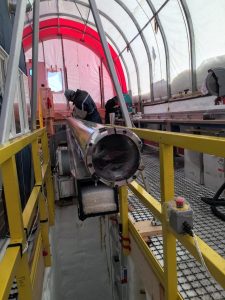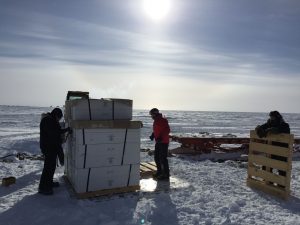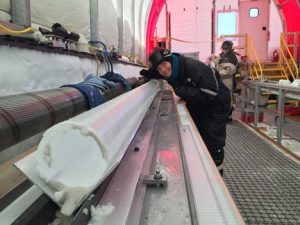Reconstruction of temperature, accumulation rate, and layer thinning from an ice core at South Pole, using a statistical inverse method
Using multiple data sets from the South Pole ice core to constrain past changes in climate and ice dynamics
Key Points & Overview
- An inverse method using a firn model with isotope diffusion provides self‐consistent temperature, accumulation rate, and thinning histories.
- Glacial‐interglacial temperature change at the South Pole was 6.7 ± 1.0 K. The δ18O/T sensitivity is 0.99 ± 0.03 permille/K.
- Reconstruction of ice thinning shows millennial‐scale variations in thinning function and decreased thinning at depth compared to 1‐D model.
- This work provides confidence in the credibility of climate models to simulate Antarctic climate change over glacial-interglacial periods.

We drilled a new ice core at the South Pole to learn about past climate change and ice dynamics. From 2014 to 2016, the core was drilled to a depth of 1751 meters, reaching an age of about 54,000 years before present. This record provides information on how the climate has changed from the middle of the last glacial period through today.
A major question of our research was how much colder than present was the Last Glacial Maximum (~20 ka before present), known as the glacial-interglacial temperature change. Previous East Antarctic studies have used measurements of water isotope ratios from ice cores as a proxy for past temperature change. This technique has been successfully used with data from many cores, but it requires independent knowledge about the relationship between temperature and water isotopes. Using estimates of this relationship, most of these East Antarctic ice core studies have found a glacial-interglacial temperature change of about 9 degrees C. However, most computer climate models (GCMs) run for this time period suggest a change of only about 5 or 6 degrees C, resulting in a longstanding model-data discrepancy for the glacial-interglacial temperature change.

With the new, high-resolution data from the South Pole ice core, we developed a novel technique to combine information from multiple data sets, including measurements of gas bubbles trapped in the ice, the thickness of annual layers of ice, and high-frequency information from the measurements of water isotope ratios. Using these multiple sources of information allowed us to independently constrain the relationship between temperature and water isotopes, unlike the estimates made from previous ice core studies. Our results give a glacial-interglacial temperature change of about 6 degrees C, falling in line with the GCM results. A recent paper published in Science (Buizert et al. 2021) used a similar method on multiple ice cores from East Antarctica and found the same result. In total, this work provides confidence in the credibility of climate models to simulate Antarctic climate change over glacial-interglacial periods.

This research comprised the bulk of my PhD thesis, which took about 5 years to complete. Ice core projects are inherently collaborative, and I am very grateful for the chance to work with researchers from many universities both in the field and back home. I very much enjoyed the opportunity to spend two seasons at the South Pole helping to drill the ice core. This paper is the result of a massive team effort, and I thank everyone involved!